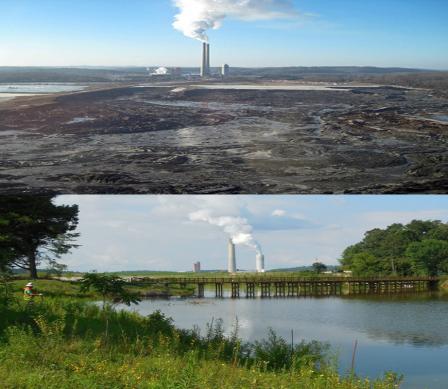Photo Description: From a critical coal fly ash disaster in 2008 to widespread ecological and community revitalization, the TVA Kingston Fossil Plant Fly Ash site and Emory River in Kingston, Tennessee are now thriving community assets.
As the Environmental Protection Agency (EPA) marks its 50th anniversary this year, it also marks a key milestone for the Comprehensive Environmental Response, Compensation, and Liability Act (CERCLA), more commonly known as Superfund. CERCLA, enacted December 11, 1980, marks its 40th anniversary this month. CERCLA authorized the land contamination cleanup program and has served as a model of environmental protection around the world.
Superfund cleanups today include everything from cleaning up spills from train derailments to removing abandoned drums from closed and abandoned warehouses. Under CERCLA, widespread and complex contaminations caused by decades of waste disposal, often found in rivers and lakes, are investigated and cleaned up. Superfund allows EPA to clean contaminated sites and requires parties responsible for contamination to either perform cleanups or repay the government for EPA-led cleanups. Since CERCLA was enacted, billions of dollars have been invested into cleaning up these contaminated sites.
Remediating Superfund sites has helped communities turn abandoned and contaminated industrial sites, landfills, and former smelters into parks, solar farms, and other useful establishments for the public. Initiated by the discovery that homes were built on an industrial dump site at Love Canal in Niagara Falls, New York, the country focused its attention to the dire need to better manage hazardous waste. This led to the creation of the Superfund program. Since its inception, the Superfund program has cleaned up thousands of sites across the country.
Other advancements in recent years include the creation and deployment of the following:
- Brownfields Program, which provides grants and technical assistance to communities, states, tribes, and others to assess, safely clean up and sustainably reuse contaminated properties.
- Administrator’s Emphasis List, which has shown to be an effective tool for promoting more timely and effective cleanups. Since 2017, 20 sites have been removed from the list after achieving critical milestones that furthered site cleanup or addressed issues slowing progress at a site.
- Superfund Task Force, commissioned in May of 2017, brings together EPA staff and leadership to review the program and implement process improvements to streamline site remediation.
In honor of CERCLA’s 40th anniversary, EPA published an archive from the 1970’s with photos and videos showing the nation awakening to the public health crisis caused by land contamination. View the archive by clicking here!
Lori Purnell, MPH, PE, Spencer-SHE’s principal engineer and partner, has experience working with NIEHS grant programs under CERCLA since 1986 and has contributed to two textbooks published regarding hazardous waste management and site remediation: Worker Protection During Hazardous Waste Remediation and Emergency Responder Training Manual for the Hazardous Waste Technician, both published by The Center for Labor Education and Research. This work has been an integral part of Spencer-SHE’s environmental goals and services.
Our team of experts are here to assist you and your facility’s environmental compliance needs. Don’t wait until EPA or your state agency shows up at your door; contact us today! For more information regarding EPA’s Superfund program click here.
For more information regarding EPA’s Superfund program click here.

